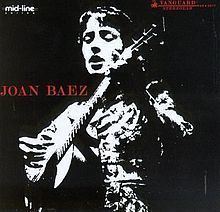Released October 1960 | Length 46:02 Release date 1960 | |
 | ||
Similar Joan Baez albums, Folk music albums | ||
3joan baez silver dagger
Joan Baez is the self-titled debut album by folk singer Joan Baez. The album was recorded in the summer of 1960 and released the same year. The original release featured 13 traditional folk songs, later reissues included 3 additional songs.
Contents
- 3joan baez silver dagger
- Joan baez greatest hits best of joan baez
- History
- Reception
- Accolades
- Songs
- References
In 2015, the album was selected for induction into National Recording Registry of the Library of Congress for special recognition and preservation as one of the sound recordings in over 130 years of recording history that has "cultural, artistic and/or historical significance to American society and the nation’s audio legacy".
Joan baez greatest hits best of joan baez
History
Baez came to prominence during the Folk Music Revival in the late 1950s, particularly in the first Newport Folk Festival in July 1959. A number of people tried to sign her after her performance at the music festival, including Columbia, but she chose to go instead with the small independent label, Vanguard. Baez recorded the album for the label in the summer of 1960 when she was nineteen.
Most of the songs featured only Baez' vocals and guitar, with a second guitar (played by Fred Hellerman, of The Weavers), added to some songs. Despite the lack of strings and horns, backup singers and hit singles, the album went gold, although it did not make the Billboard 200 chart until 1962, following the success of her second album, Joan Baez, Vol. 2. Joan Baez peaked at number 15 and spent 140 weeks on the chart.
In 1983 Baez described the making of the album to Rolling Stone's Kurt Loder:
It took four nights. We were in some big, smelly ballroom at a hotel on Broadway, way up by the river. We couldn't record on Wednesday nights because they played bingo there. I would be down there on this dirty old rug with two microphones, one for the voice and one for the guitar. I just did my set; it was probably all I knew. Just put 'em down. I did "Mary Hamilton" once, that was it. That's the way we made 'em in the old days. As long as a dog didn't run through the room or something, you had it.
In 2001, Vanguard reissued Joan Baez with new liner notes and three previously unreleased songs. (Between 2001 and 2005, they reissued remastered versions of Baez' thirteen original albums with the label.)
In 2014, Waxtime Records reissued Joan Baez with new liner notes and only two bonus tracks from earlier Baez sessions that were originally released in 1959 on the compilation LP Folksingers' Round Harvard Square. These two bonus tracks appear as, track 8 side 1 : O What a Beautiful City and Track 7, side 2; Black is the Color of my True Love's Hair.
Reception
In his Allmusic review, music critic Bruce Eder gave the album five out of five stars, commenting that the purity of the sound was notable at the time. He wrote of the album "Baez gives a fine account of the most reserved and least confrontational aspects of the folk revival, presenting a brace of traditional songs (most notably "East Virginia" and "Mary Hamilton") with an urgency and sincerity that makes the listener feel as though they were being sung for the first time"
Accolades
The album was included in Robert Dimery's 1001 Albums You Must Hear Before You Die.
In 2015, the album was deemed "culturally, historically, or aesthetically significant" by the Library of Congress and selected for inclusion in the National Recording Registry.
Songs
1Silver Dagger2:32
2East Virginia3:44
3Fare Thee Well3:22
